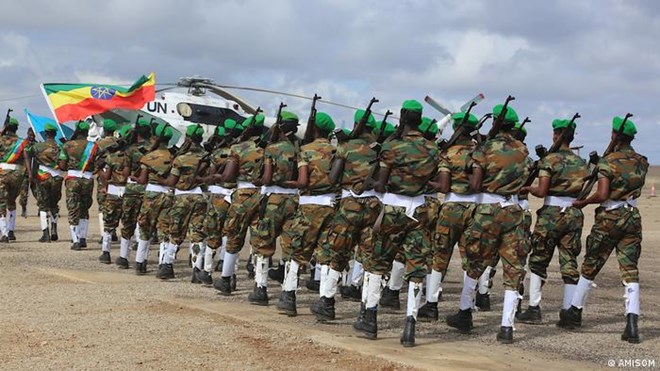
Friday July 29, 2022
By Jeff Seldin Mohamed Olad
Ethiopian troops first started serving as part of AMISOM in 2014
WASHINGTON — A concerted push by al-Qaida-linked al-Shabab to expand from Somalia into Ethiopia appears to have been “largely contained,” according to a senior U.S. military official, though he cautioned that the terror group was likely planning more such attacks in coming months.
Almost 500 al-Shabab fighters first crossed into eastern Ethiopia last week, clashing with Ethiopian forces along the border. U.S. assessments suggest they may have penetrated as much as 150 kilometers into Ethiopia before being stopped.
“It appears that the Ethiopians have largely contained and defeated this incursion,” General Stephen Townsend, the outgoing commander of U.S. Africa Command, said Thursday during a call with the Washington-based Defense Writers Group.
“Our brave soldiers foiled a plan al-Shabab was working on for at least a year and defeated the fighters they sent to Ethiopia within three days,” Mustafe Omer, the president of Ethiopia’s Somali region, told reporters.
Omar also said that Ethiopia is planning to create a “security buffer zone” aimed at countering al-Shabab attacks.
“We cannot merely watch an open border where the militants mobilize themselves on the other side [Somalia] to attack us,” he said. “We must prevent such a threat and not wait until they come to our border.”
AFRICOM’s Townsend agreed al-Shabab will try again.
“This is not a fluke. … I don't believe this is a one-off,” he added in response to a question from VOA.
“It's only been less than a year ago that al-Shabab emir [Ahmed] Diriye called for an increased emphasis on external attacks and increased emphasis on attacking Western targets in the Horn of Africa,” Townsend said. “This is a response.”
According to intelligence shared by U.N. member states, al-Shabab currently commands between 7,000 and 12,000 fighters and is spending approximately $24 million a year – a quarter of its budget – on weapons, explosives and increasingly on drones.
Townsend further warned Thursday that al-Shabab has been emboldened by recent political turmoil in Somalia, which consumed the attention of Somali officials and politicians for much of the last 18 months, as well as by the December 2020 decision by then-U.S. President Donald Trump to end a U.S. troop presence in Somalia.
That decision has since been reversed, and the AFRICOM commander said Somalia’s new president, Hassan Sheikh Mohamud, has also taken positive steps.
“Al-Shabab got bigger, bolder, stronger,” Townsend said. “So now we've got to blunt the initiative that they've [al-Shabab] enjoyed for 15 months or more.
“We've already seen an uptick in Somali security forces operations,” he added.
U.S. officials and some analysts worry that in addition to Ethiopia, which al-Shabab had previously attacked in 2013 and 2014, al-Shabab also plans to expand operations in Kenya, Djibouti and beyond.
“The militants have been enjoying in their movements and military mobilizations because of the absence of Somali National Army offensives against their hideouts and the areas they still control,” said Abdisalam Yusuf Guled, the former deputy head of the Somali National Intelligence and Security Agency.
“So they [al-Shabab militants] have got the choice to attack wherever they want and whenever they want,” he said. “To me, it [Ethiopia] was a rare attack but always predictable.”
There is also growing concern that al-Shabab is growing more powerful and more influential within al-Qaida itself.
Intelligence from the U.S. and from U.N. member states indicates al-Shabab leader Ahmed Diriye, also known as Ahmed Umar Abu Ubaidah, is part of al-Qaida's Hittin Committee, which directs the group’s global operations.
The intelligence further suggests that al-Shabab, rather than taking money from al-Qaida’s core leadership, is directly funding it with some of its revenue.